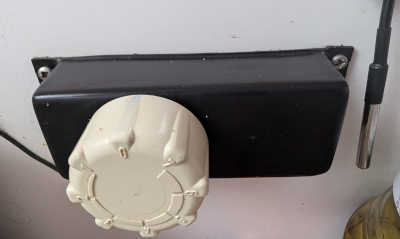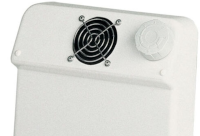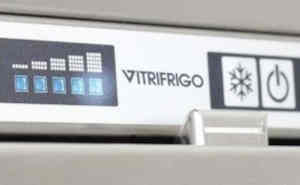
This "Refrigerator optimizer" is more than just a thermostat. It enhances comfort, offers many power saving optimizations, combats frost on the evaporator, incorporates Smart Fan Control, logging, and much, much more. This is truly the ultimate marine/RV refrigerator "thermostat".
Features
- Liquid Crystal Display with digital readout of the actual refrigerator temperature, target temperature, trend, voltage and status.
- Automatic boosts cooling effort and uses the refrigerator as a "cold bank" when a charge voltage is detected.
- Adaptive Energy Optimization by varying the RPM of the compressor.
- Temporarily pauses cooling when the voltage drops due to a heavy load.
- Switches beverage-only fridges off during the night or when the electricity is in short supply.
- Quick menu to select between program modes.
- Smart Fan Control, depending on evaporator temperature, and with configurable after run.
- Minimizes frost buildup on the evaporator.
- Automatic defrost mode.
- Temperature alarm when the temperature has exceeded a configured level.
- Saves space inside the fridge, no bulky thermostat but just a small sensor is needed.
- Logging of power consumption over the last 24 hours.
- Battery protection (shuts off below a configurable voltage).
- Fully configurable by an on screen menu with touch button interface.
- High precision temperature sensors, but also compatible with existing sensors.
- Configurable between degrees Celsius and Fahrenheit, 12 and 24V systems, Fridges and Freezers, analog and digital temperature sensors.
- Monitoring and diagnostics of BD-compressors.
- Emergency modes when moisture has contaminated the refrigerant or when the temperature probe is broken.
- Low energy consumption.
- Easy to install.
- See also my generic project backgrounds page for more information about the design philosophy.
Description

Let's talk a bit more about these features and how they work.
Auto boost
The auto boost feature utilizes more energy when an abundance is available, to save more energy when it is scarce.
When the on board voltage exceeds a certain level, it indicates that a charge current is present. The refrigerator will then lower its target temperature, increase the RPM of the compressor (if you have a BD35/BD50/BD80 compressor), and uses the refrigerator as a "cold bank" to store extra energy. When the charge current disappears, the refrigerator then needs less energy from the batteries for some time.
- For a beverage fridge you can set the maximum and minimum temperatures far apart (unless you want to have very cold drinks early morning), with the result on a solar panel fed system that the fridge shuts off around sundown to start up again somewhere in the late morning when the batteries have recharged enough.
- For a standard fridge the energy saving is less dramatic but still a lot of energy can be saved, especially if a wide margin between allowable temperatures is set.
- For a freezer there is no lower limit, so they are ideal to store lots of cooling energy when an abundance of energy is available, and then to switch off for quite a long time until the temperature has climbed up to the upper allowable limit.



Adaptive Energy Optimization
Some 95% of all marine and RV refrigerators use the BD35, BD50 or BD80 compressors from Secop (formerly Danfoss). A little known feature of these compressors is that their RPM (rotation speed) is variable. Almost no thermostats use this feature and just toggle the compressor on and off to maintain the set temperature. But this Refrigerator Optimizer varies the RPM and tries to find the sweet spot where the desired temperature can be maintained with the lowest possible RPM. This has the following benefits:
- It saves some 15% of the energy compared to just on/off cycling.
- Faster cool down times, but with less temperature "overshoot".
- Less frost on the evaporator because of higher average evaporator temperature.

Auto pause
The auto pause temporarily halts the compressor when the on board voltage drops due to a heavy load, such as an anchor winch, water cooker, induction stove, etc. This way more current is available to the heavy consumer and the battery load is kept smaller.


Quick menu
A quick menu allows you to instantly switch between Automatic mode, Boost mode, Eco mode, Defrost mode, or just switch the refrigerator off.
Smart Fan Control

Usually the condenser/compressor unit has a cooling fan (or water cooling pump) on the condenser. Sometimes, the evaporator (inside the refrigerator) has a fan too. The fans are normally wired in parallel with the compressor, so they turn on and off at the same moment the compressor turns on and off.

There is however a smarter way to control the fans: The condenser fan could be working a bit longer when the compressor stops and the condenser is still warm. The fan inside the fridge should run until the temperature of the evaporator nears the temperature of the fridge. This makes sure that the "cold" which is still inside the evaporator is not used to form a frost layer but is distributed inside the refrigerator to further cool its content. Again the energy is used more wisely and it reduces the frost buildup on the evaporator.
Prevention/cure of frost buildup on the evaporator

The Adaptive Energy Optimization and Smart Fan Control both help to prevent frost buildup. In addition (Fridge mode only) there is a defrost mode that can be either manually or automatically activated. What it does is to wait for a moment when the temperature difference between the evaporator and fridge contents is low to begin with (such as after having switched from boost to normal mode) and it then keeps the fans running while the compressor remains off, until the evaporator temperature increases to just above the freezing point. Then it switches back to normal mode again.
Temperature alarm

When the temperature inside the refrigerator exceeds a configured temperature for more than 10 minutes, it will show an alarm, even if the temperature drops down to safe levels again afterwards. Especially in the case of freezers, it can alert you when, for some reason, the temperature has at some moment been too high for the food to remain safe.
Temperature sensors


The Refrigerator Optimizer works best with the supplied high precision digital temperature sensors, but it is also compatible with a wide range of analog (thermistor) sensors.
So if your refrigerator already has a temperature sensor (thermistor) built in, it can be re-used to make the installation process easier.
Logging of energy consumption
The Refrigerator Optimizer is aware of the power profile of the BD35, BD50 and BD80 compressors and can, based on their RPM and evaporator temperature, closely approximate their power consumption. This power consumption is logged over a rolling 24 hour window, for the total and eco mode, and allows you to study the effect of different settings, environment temperatures, frost buildup, etc.


Battery protection
You can configure a minimum allowable voltage, to protect your batteries and/or to keep other equipment (GPS) running longer.
Monitoring and diagnostics of BD-compressors

The BD35, BD50 and BD80 compressors have a diagnostics output to help troubleshooting. The Refrigerator Optimizer monitors this output and signals any problem in clear text on the LCD. No more cumbersome and confusing LED diagnostics!
Emergency mode to keep the fridge running when moisture has contaminated the refrigerant or when the temperature probe is broken
If there is a problem with the temperature sensor, you can run the refrigerator with a configurable on/off duty cycle until the problem is solved.
A unique feature not found in any other thermostat/temperature controller is its ability to deal with refrigerant moisture contamination, which is a common failure mode. The result of moisture contamination is that the refrigerator runs for a few minutes until ice blocks the flow of refrigerant and cooling beyond the ice blockage totally ceases. The Refrigerator Optimizer has a special emergency mode in which the ice blockage is melted as soon as it occurs, to keep the fridge running with reduced capacity until a technician can remedy the problem.
Configuration
All relevant information is not just only visible on the LCD, but also fully configurable by an on screen menu and touch button interface.



Easy to install

The Refrigerator Optimizer is easy to install in any panel, thanks to the flanges on its front panel, but if you bought the optional matching casing you can also install the Refrigerator Optimizer as a self contained unit. The bezel and 3mm stainless steel alan bolts are included.
All electrical connections are easy and fast thanks to marked screw terminals on the rear side.
See for detailed installation instructions the Documentation.


More information
Documentation (Usage & Installation)
Consult the Documentation for more information about the installation and usage of the Refrigerator Optimizer.
Project background
For more information about the general design philosophy of the projects of TheFloatingLab, please visit the Project Backgrounds page.
Ordering
The Refrigerator Optimizer can be bought as a completely assembled version, or as a kit (some soldering required).
The completely assembled version costs 197 USD, the kit version 172 USD.
One temperature probe is included, which is sufficient to use the majority of the functions, but if you want to use Automatic Defrost (fridge only), enhanced power logging, smart fan control on an evaporator fan, and be able to use the emergency mode (fridge only). you need an additional temperature probe on the evaporator plate.
Ordering information will be available soon. If you are in a hurry, contact me.
Specifications
| Voltage: | 8-30V |
| Current: | <1mA with the compressor idle and LCD in glow mode, <10mA with running compressor and LCD backlight fully on. |
| Temperature accuracy: | +/-0.5°C |
| Voltage accuracy w/o calibration: | +/-0.1V |
| Front panel dimensions: | 110 x 68mm |
| Required panel cut out: | 90 x 55mm |
| Compatibility: | Any fridge, but Adaptive Energy Optimization, logging, and compressor diagnostics are only available with the BD35, BD50 and BD80 compressors. |
| Temperature sensors: | Compatible with:
|
ZwerfCat Example
My life on ZwerfCat has led to the development of the Refrigerator Optimizer:
Automatic boost
On ZwerfCat, our main fridge is set at 6.5°C, but it will boost to 1.5°C when the on board voltage is above 13.6V, which indicates that a charge current is available. During the day, when the solar panels are producing power, or an alternator is running, the temperature will drop to the boost setting, and in the first half of the night it doesn't need any power anymore while allowing the temperature to creep up to 6.5°C. My batteries thank me.
One of our (power hungry) fridges is dedicated to beverages. In the morning we usually don't drink any beer cooled beverages so it is useless to use energy during the night to keep them at consumption temperature. Actually, in the morning we usually drink tea and only start drinking cooled beverages in the afternoon. So, before we had the fridge optimizer, we tried to remember to turn off the "beverage fridge" at sundown, and to turn it on again somewhere late morning when the solar panels were already generating a lot of power. This was giving the fridge enough time to cool our drinks to be ready in time, while saving a lot of power overnight and allowing the evaporator to defrost. This process is now automated, leading to more power savings and more comfort at the same time.
The freezer maintains a temperature of -13°C, but once the voltage reaches 13.8V, indicating a nearly full lithium battery, it will start to run at full power and store as much energy as it can harvest. Consequently it needs less power once the system voltage starts to drop again.
All our refrigerators temporarily pause when the voltage drops below 13 Volts (we have a lithium battery, on lead acid batteries this value should be lower) which indicates that a heavy consumer is switched on, such as the water heater, coffee machine, anchor winch, etc. This to ease the system load. With two fridges and one freezer it all adds up.
Defrosting
We often had frost accumulation on the evaporator inside the fridge, even though we had the temperature of the fridge set above freezing temperature. What was going on?
- The interval (hysteresis) of the fridge was too low. The thermostat was restarting the fridge again before the tiny frost layer had melted, leading to an increasingly bigger buildup over time.
- One of our fridges has fans to force air flow inside the fridge, but they stopped together with the compressor, while they could be running for much more time to make sure that all the cold energy stored inside the evaporator is used to cool down the fridge and its frost layer melts off before the compressor fires up again. The smart fan control really helped a lot.
Emergency mode
One day our main fridge stopped working. The compressor was running constantly but no cooling took place at all. I switched off the fridge to troubleshoot later, to find out the next day that the fridge was starting up normally, but then after a few minutes ceased to cool any further. It turned out that there was moisture in the refrigerant and that moisture was freezing up inside the capillary tube, totally blocking the flow of refrigerant. This happened of course in the second half of December with limited availability of technicians and parts.
I then created a special emergency mode in which the Refrigerator Optimizer would enter defrost mode as soon as the evaporator hits the freezing point... and that worked! Every few minutes the compressor would stop, waiting for the temperature of the evaporator to raise above freezing again, then to restart, repeating this process over and over, and this way the fridge could avoid the ice blockage while limping the temperature down to 5 degrees again.
